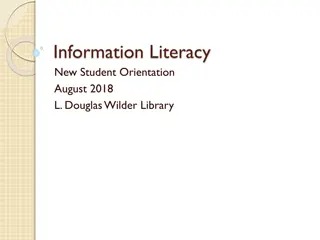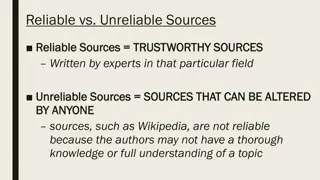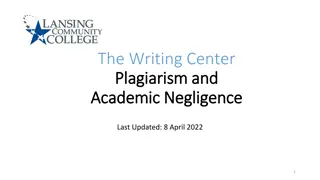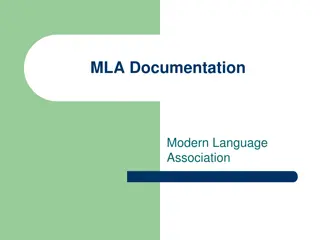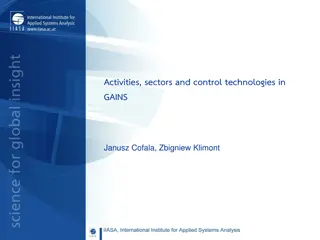Ways of acknowledging sources
In academic writing, acknowledging sources is crucial through methods like quotation, citation, reference, and summarizing. Understanding these elements aids in proper attribution and credibility. Each plays a significant role in academic integrity and proper documentation of ideas and research. Quoting exact words, providing citations with author details, creating references with full information, compiling references and bibliographies, and summarizing key points all contribute to a well-rounded academic practice.
Uploaded on Mar 04, 2025 | 5 Views
Download Presentation

Please find below an Image/Link to download the presentation.
The content on the website is provided AS IS for your information and personal use only. It may not be sold, licensed, or shared on other websites without obtaining consent from the author.If you encounter any issues during the download, it is possible that the publisher has removed the file from their server.
You are allowed to download the files provided on this website for personal or commercial use, subject to the condition that they are used lawfully. All files are the property of their respective owners.
The content on the website is provided AS IS for your information and personal use only. It may not be sold, licensed, or shared on other websites without obtaining consent from the author.
E N D
Presentation Transcript
+ Ways of acknowledging sources Essential Aspects of Academic Practice #2 John Morgan Student Learning Support Aberystwyth University jpm@aber.ac.uk
+Working definitions How would you describe each of the following? Quotation Citation Reference Bibliography Summarising Paraphrasing
+Definitions #1 Quotation Using the exact words that have been published in a book, journal article, web-site or any other recorded document or resource. A quotation must be accompanied by use of quotation marks . Some style guides may indicate that quotation marks should not be used for block quotations when the quote is set apart from the text (e.g. MHRA). A quotation in all cases must be accompanied by a citation.
+Definitions #2 Citation A citation indicates the name of the author, the year and sometimes the page number of where the idea was published. It is often accompanied by use of a reporting verb: X (2010, p.21) argues that From X s argument (2010, p.21) it can be seen that The citation may be included in a footnote or endnote: There are a number of reasons that support this perspective.1 Citations must be used with quotations and they must also be used when you write ideas in your own words.
+Definitions #3 Reference A reference gives full details of the source you are using. It appears as a single entry in a bibliography. Some style guides recommend that a reference appears in the first footnote at the bottom of the page, with following footnotes to the same source only appearing as a citation (e.g. MHRA). It includes author s name, editor (if appropriate), year of publication, title (and subtitle) of source, edition (if 2nd or later), city of publication, publishing company. These will appear in different sequences in different styles. This above sequence is for Harvard or APA.
+Definitions #4 References & bibliography A list of references includes all sources cited in the work you are presenting. A bibliography includes all work you have consulted in the development of your work. It is a good idea to cite all works you have consulted, thus creating a list of references rather than a bibliography. In some cases not citing a work you have consulted may be a problem if it is clear that the idea was derived from, or developed by, an author you haven t cited.
+Definitions #5 Summarising Summarising provides an overview of the key points in a published text. It can be a focus on the them of a whole book or article, chapter or shorter extracts such as a page or a series of paragraphs. The aim is to identify key points and reduce the length of the original to provide ideas that support the aims and focus of your own essay, i.e. you need to connect the ideas to your own argument or interpretation of issues. Summarised ideas must be accompanied by a citation.
+Definitions #6 Paraphrasing Paraphrasing provides a detailed summary of a short extract from a published source. Paraphrased ideas are often similar in length to the ideas in the published source. Some key concepts will appear in both texts, but the expressive words will be different. Paraphrased ideas must be connected to your own argument and as such, they will not follow the exact sequence of the original (this is often referred to as close paraphrasing ). Paraphrased ideas must be accompanied by a citation.
+Your own words An important point to consider is that a piece of academic work needs to be written or articulated in your own words. It is centred on your own interpretation of an issue and your own argument. As such any published ideas are there to support your views (whether you agree with them of not).
+Source of ideas Your views may include ideas that are quoted, summarised or paraphrased from other published sources. In each case it is essential to include a citation to the sources where ideas appear. Even when describing ideas that we have developed ourselves it is necessary to include citations, if those ideas are related to, or can be identified as originating in other published ideas. In essence we need to be able to acknowledge how we developed our ideas. This indicates that it is not only the exact words of original sources that need acknowledgment, but also those adapted or derived from other sources that are written in our own words.
+Approaches to quotation and citation #1 Direct quotations are the exact words of the original author. These MUST have quotation marks: or Check your departmental style guide for use of single or double quotation marks.
+Approaches to quotation and citation #2 You must also add a citation the author s name, year of publication and page number (where relevant). If the author s name is included in your sentence, it is an integral citation. If the author s name is included in brackets or in a footnote or endnote, it is a non-integral citation. Citations may be added in a footnote or an endnote. Check your departmental style guide for preferences on use of citations.
+Approaches to quotation and citation #3 When set inside the sentence structure, a quotation should be no longer than two lines. It should be edited to fit the grammatical pattern of your own sentence. Three dots are used to indicate where the quotation has been edited. Below is an example from one of my own postgraduate essays in linguistics: The assignation of signs coming before the formal relation of signs to one another (Morris, 1938: 6), means that Chomsky s ideal speaker-listener in a completely homogeneous speech community (Chomsky, 1965: 3, in Hymes, 1971) at least has a functional framework in which to use his/her inherent rule-based creativity, meaning more importantly, that performance factors are the essential study of linguists
+Approaches to quotation and citation #4 Where footnotes or endnotes are used, citations appear at the bottom of the page. These are not a substitute for a bibliography, which must also be included. Below is the same text from my postgraduate essay, but this time using footnotes instead of in- text citation. Footnotes appear at the bottom of this page and the references appear in the bibliography at the end of the document: The assignation of signs coming before the formal relation of signs to one another ,1means that Chomsky s ideal speaker-listener in a completely homogeneous speech community 2 at least has a functional framework in which to use his/her inherent rule-based creativity, meaning more importantly, that performance factors are the essential study of linguists 1. Morris, 1938: 6 2. Chomsky, 1965: 3, in Hymes, 1971
+Approaches to quotation and citation #5 When set apart from the text as a separate text block, a quotation should be longer than two lines, but in most cases no more than five or six lines. The whole quotation should be preceded and followed by a line break. It should be indented by one tab space on the keyboard and the citation should appear below in brackets. Check your style guide for whether it should have quotations marks or not. Limit such quotes to a maximum of 5-7 lines. Linguistic theory is concerned primarily with an ideal speaker-listener, in a completely homogeneous speech community, who knows its language perfectly and is unaffected by such grammatically irrelevant conditions as memory limitations, distractions, shifts of attention and interest, and errors (random or characteristic) in applying his knowledge of the language in actual performance. (Chomsky, 1965: 3, in Hymes, 1971)
+Should I use quotations or not? #1 Quotations are used when phrases, expressions, assertions or arguments written by others perfectly and/or succinctly exemplify the point being made. In some cases they are very well known and inclusion of the quotation helps to contextualise the discussion. It is important here though not to use a quotation in isolation from the context of the wider discussion of the source in which it appears.
+Should I use quotations or not? #2 The quote from Chomsky (1965: 3) on the earlier slide is included in a paper by Hymes (1971), in which Hymes criticises Chomsky s view of language and it is important to acknowledge this. Here you should search for the original, but if citing Hymes as well, it is important to draw connections between the two ideas.
+Should I use quotations or not? #3 At this point it is necessary to include a chain of references in your bibliography not just the reference to Hymes. When we do this we also find that Hymes paper is a chapter in an edited collection by Brumfit and Johnson (1979). As such we immediately need three references in the bibliography, e.g.
+Should I use quotations or not? #4 Brumfit, C. & Johnson, K. (Eds.) (1979). The Communicative Approach to Language Teaching. Oxford: Oxford University Press. Chomsky, N. (1965). Aspects of the Theory of Syntax. Cambridge: M.I.T. Press. In Hymes, D. (1971). Hymes, D. (1971). On Communicative Competence. In Brumfit, C. & Johnson, K. (Eds.) (1979). Refer to your style guide for exact layout of references
+Should I use quotations or not? #5 A quotation can be used: to start a critical discussion; to provide an example that supports your own critical discussion; to summarise your own critical discussion; when there is ambiguity or doubt leading to more than one possible interpretation of the text. In each case it adds authority to your own argument and displays an awareness and understanding of how you are using the literature in your field to engage with issues you are writing about.
+Should I use quotations or not? #6 A quotation must not be used: to replace your own discussion; to string together ideas that have no direct critical connection with your perspective or argument; when it is not interpreted or cited.






